1. Overview: the key steps in cellular respiration
[qwiz qrecord_id=”sciencemusicvideosMeister1961-Key Steps in Respiration (HS interactive reading)”]
[h] Glucose to ATP
[i] Let’s follow the fate of one glucose as its chemical energy gets converted into ATP
[q] Here’s glucose. It’s a highly reduced molecule. You can tell because of all of its [hangman] atoms (hint: it’s an element that begins with “H”). That means that glucose has lots of chemical [hangman].
[c]IGh5ZHJvZ2Vu[Qq]
[f]IEV4Y2VsbGVudCE=[Qq]
[c]IGVuZXJneQ==[Qq]
[f]IEdvb2Qh[Qq]
[q] When glucose diffuses from the cell exterior into the cytoplasm, it encounters a series of enzymes. In the diagram below, this encounter would be happening at number ___.
[textentry single_char=”true”]
[c]ID M=[Qq]
[f]IFllcywg4oCcM+KAnSBpcyB0aGXCoGN5dG9wbGFzbS4=[Qq]
[c]ICo=[Qq]
[f]IE5vLiBUaGUgY3l0b3BsYXNtIGlzIHRoZSByZWdpb24gYmV0d2VlbiB0aGUgY2VsbCYjODIxNztzIG1lbWJyYW5lIGFuZCB0aGUgbnVjbGV1cyAod2hpY2ggaXNuJiM4MjE3O3Qgc2hvd24gaW4gdGhpcyBkaWFncmFtKS4gV2hpY2ggbnVtYmVyIGlzIGp1c3QgaW5zaWRlIHRoZSBtZW1icmFuZSAoYnV0IG5vdCBwYXJ0IG9mIGFueSBvdGhlciBzdHJ1Y3R1cmUpPw==[Qq]
[q] Take a moment to study the diagram below. See if you can use it to figure out the key things that happen during glycolysis. When you’re ready, move on to the next question.
[q] During glycolysis, enzymes
- Take glucose, a six-carbon molecule, and split it apart into two [hangman]-carbon molecules.
- Use glucose’s chemical energy to reduce two molecules of NAD+ to two molecules of [hangman]..
- Use glucose’s chemical energy to add a phosphate groups to two molecules of ADP, making two [hangman]s.
[c]IHRocmVl[Qq]
[f]IEdvb2Qh[Qq]
[c]IE5BREg=[Qq]
[f]IENvcnJlY3Qh[Qq]
[c]IEFUUA==[Qq]
[f]IEdvb2Qh[Qq]
[q] The splitting of glucose leaves us with two 3-carbon molecules called pyruvic acid (which is not shown in the diagram below). This pyruvic acid now needs to enter the [hangman], which is shown at “4.”
[c]IG1pdG9jaG9uZHJpYQ==[Qq]
[f]IEdvb2Qh[Qq]
[q] A series of reactions, collectively called the “link reactions” follows glycolysis. These reactions link glycolysis, which occurs in the cytoplasm to the reactions that occur in the mitochondria matrix.
Note that the image at left represents an enzyme.
See if you can figure out what’s going on in the diagram below before continuing.
[q labels= “top”]During the link reaction, __________ acid (at “A”) first diffuses though the membranes of the __________. Then, it’s modified by a series of enzymes. The first one removes a ________. The second reduces NAD+ to _______. The third attaches a molecule called CoEnzyme A (represented by “C”) to the two-carbon molecule that’s left, producing a molecule called acetyl-CoA.
[l]mitochondria
[f*] Good!
[fx] No. Please try again.
[l]CO2
[f*] Good!
[fx] No. Please try again.
[l]NADH
[f*] Correct!
[fx] No. Please try again.
[l]pyruvic
[f*] Excellent!
[fx] No, that’s not correct. Please try again.
[q multiple_choice=”true”] Here’s a diagram of the link reaction. Which of the following molecules has the most chemical energy?
[c]IHB5cnV2aW MgYWNpZA==[Qq]
[f]IE5pY2UhIFB5cnV2aWMgYWNpZCBnZXRzIG94aWRpemVkIHNvIHRoYXQgdGhlIGNlbGwgY2FuIHJlZHVjZSBOQUQ=Kw==IHRvIE5BREguIFdoZW4gc3Vic3RhbmNlcyBnZXQgb3hpZGl6ZWQsIHRoZXkgbG9zZSBlbmVyZ3kuwqDCoA==[Qq]
[c]IGNhcmJvbiBkaW94aWRl[Qq]
[f]IE5vLiBDYXJib24gZGlveGlkZSBpcyBhIGxvdy1lbmVyZ3kgZXhoYXVzdCBwcm9kdWN0IG9mIHJlc3BpcmF0aW9uLg==[Qq]
[c]IGFjZXR5bCBDb0EgKGF0ICYjODIyMDtEJiM4MjIxOyk=[Qq]
[f]IE5vLiBBY2V0eWwgQ29BIGhhcyBsZXNzIGVuZXJneSB0aGFuIHB5cnV2aWMgYWNpZC4gSXQmIzgyMTc7cyB3aGF0JiM4MjE3O3MgbGVmdCBhZnRlciBweXJ1dmljIGFjaWQgaGFzIGJlZW4gb3hpZGl6ZWQgKGF0IHN0ZXAgMiksIGFuZCBveGlkYXRpb24gcmVtb3ZlcyBlbmVyZ3ku[Qq]
[q labels=”top”]After link reaction comes the Krebs cycle. Find Acetyl Co-A at about 11 O’clock. It brings chemical energy into the cycle. That chemical energy powers:
- ________ reductions of NAD+ to NADH.
- One __________ of FAD to FADH2.
- One conversion of ADP and P to ______.
Two molecule of carbon _________ are released as a waste product.
[l]ATP
[f*] Great!
[fx] No, that’s not correct. Please try again.
[l]dioxide
[f*] Excellent!
[fx] No. Please try again.
[l]three
[f*] Great!
[fx] No. Please try again.
[l]reduction
[f*] Great!
[fx] No. Please try again.
[q] Study the diagram below below before continuing.
The main thing to note is that steps “1,” “2,” and “3” have produced many mobile electron carriers such as [hangman] and FADH2, but very few molecules of life’s energy molecule [hangman].
[c]IE5BREg=[Qq]
[f]IEV4Y2VsbGVudCE=[Qq]
[c]IEFUUA==[Qq]
[f]IENvcnJlY3Qh[Qq]
[q] The last phase of cellular respiration is the electron [hangman] chain, shown at step 4. This is where the vast majority of the [hangman] made by cellular respiration gets produced
[c]IHRyYW5zcG9ydA==[Qq]
[f]IEV4Y2VsbGVudCE=[Qq]
[c]IEFUUA==[Qq]
[f]IENvcnJlY3Qh[Qq]
[/qwiz]
Now let’s take in some more of the details.
2. In the cytoplasm, glycolysis creates ATP and NADH
Glycolysis is the first step of cellular respiration. The diagram below represents glycolysis in an extremely simplified way, showing just inputs and outputs.
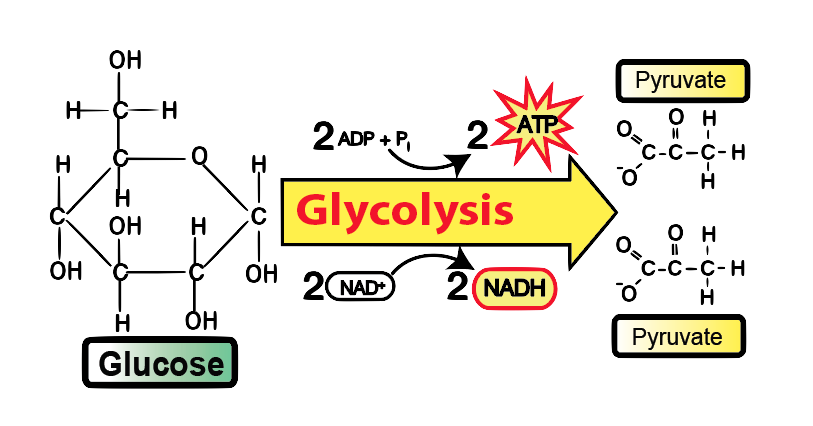
Let’s try a bit more complexity:
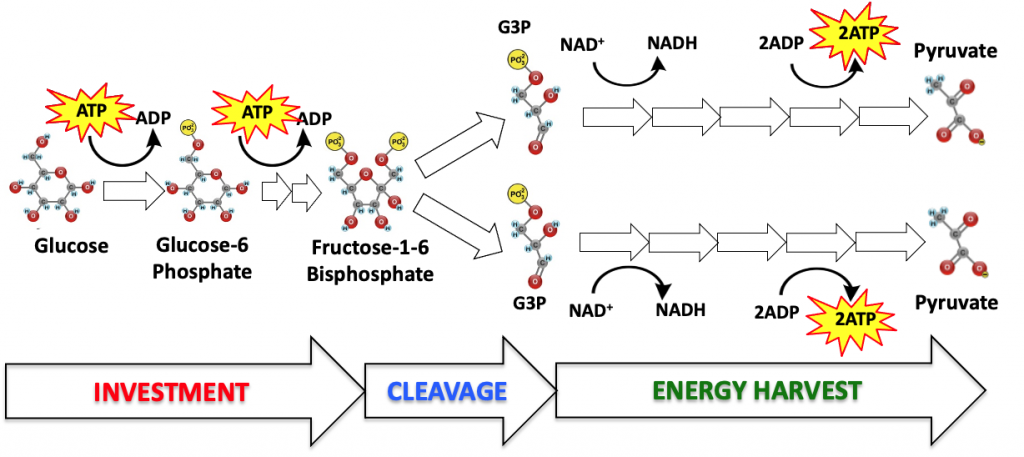
In what’s above, you can see that glycolysis starts with an investment phase. Enzymes add two phosphates to glucose, which “costs” the cell two ATPs. This investment is required to move the reaction forward.
In the cleavage phase, glucose is enzymatically split apart into two 3 carbon molecules.
In the energy harvest phase, those two 3 carbon molecules (called G3P) provide the energy to make four ADPs into four ATPs, and to reduce two NAD+ to NADH.
What do you need to know?
- The process occurs in three phases: investment, cleavage, and energy harvest.
- The process occurs in the cytoplasm.
- By the end, enzymes have split glucose, a six carbon molecule, into two three-carbon molecules called pyruvic acid (also known as pyruvate).
- Enzymes oxidize food and reduce two molecules of the electron carrier NAD+ into NADH. As you’ll remember from the last tutorial, that NADH can now be used to power synthesis of ATP.
- Other enzymes use the energy in glucose to directly convert four molecules of ADP into four molecules of ATP. However, because the cell needed to spend two ATPs during the investment phase, the overall ATP yield is two.
- No oxygen is required for glycolysis to run. When cells are using anaerobic respiration, glycolysis alone is how cells generate ATP.
3. The Link Reaction brings chemical energy into the mitochondria, and produces NADH
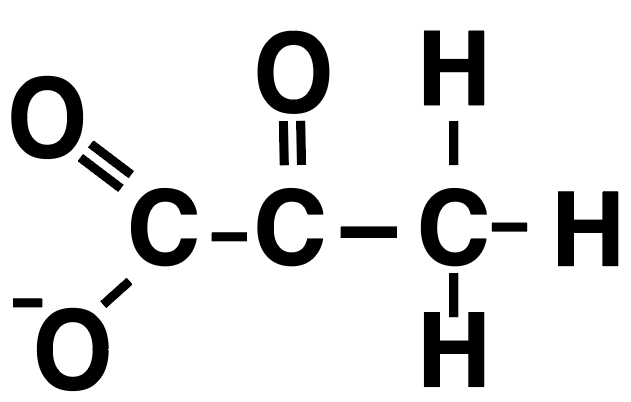
Glycolysis occurs in the cytoplasm, and results in two molecules of pyruvic acid. That pyruvic acid still has a great deal of chemical energy. That energy will be harvested in a series of reactions that occur in the mitochondrial matrix.
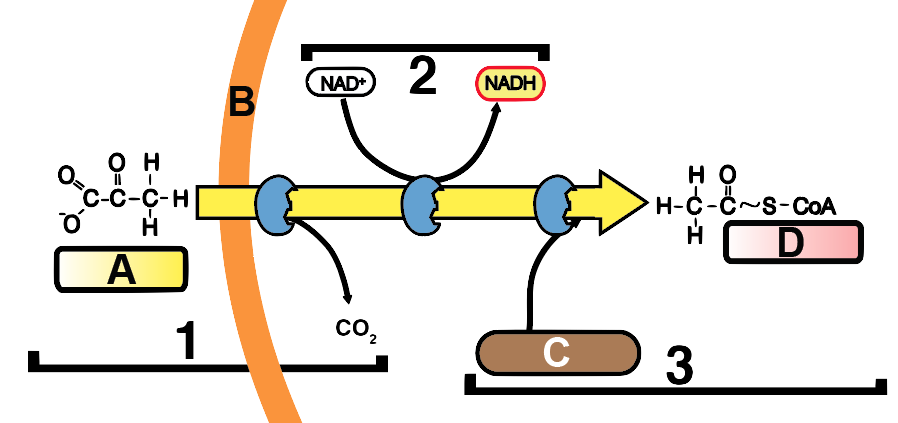
The first of these reactions is called the link reaction.
In step 1, pyruvic acid (“A” at left) diffuses through both mitochondrial membranes (“B”). As it enters the mitochondrial matrix, an enzyme snips of a carbon dioxide molecule.
At step 2 a second enzyme oxidizes what’s left of pyruvate, transferring a hydrogen and electrons from pyruvate to NAD+, creating NADH.
At step 3 a third enzyme attaches the two carbon, hydrogen and oxygen that’s left and attaches it to a compound called Coenzyme A (represented by “C”). The result is shown at “D:” acetyl Co-A.
Here’s an interesting fact about the link reaction. Relax and exhale. In what you’ve exhaled, one third of the carbon dioxide comes from the link reaction.
4. The Krebs cycle completely oxidizes what’s left of glucose, creating NADH and FADH2
After the link reaction, acetyl Co-A enters into the Krebs Cycle.
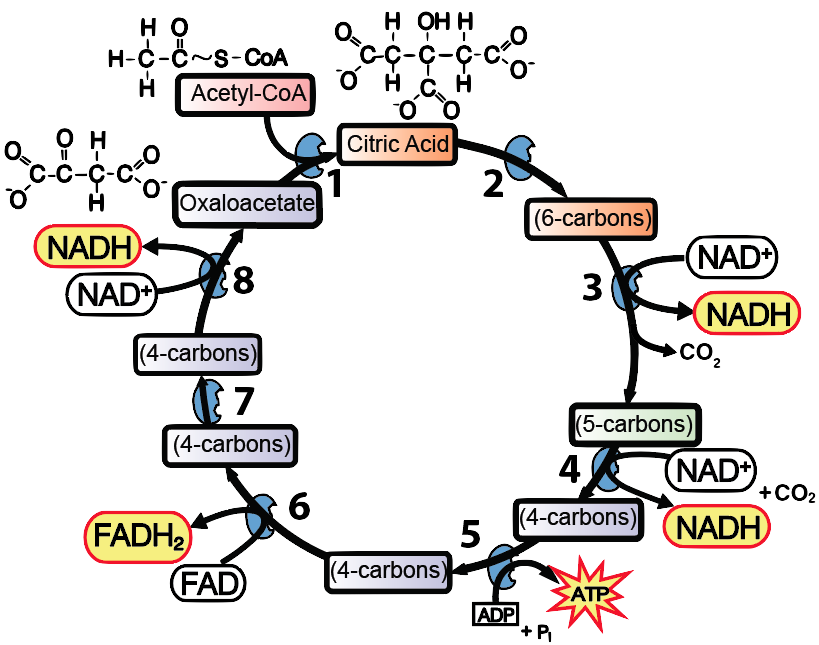
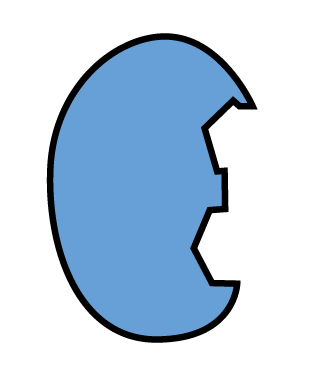
Like glycolysis, the Krebs cycle involves many enzymes.
Unlike glycolysis, however, the starting compound in the Krebs Cycle reappears at the end. That’s why it’s a cycle.
That compound is oxaloacetate, a four-carbon molecule. Look at about 10 O’clock on the diagram, and you’ll find it.
If we start with oxaloacetate, then the first enzymatic move in Krebs is combining oxaloacetate with acetyl-CoA. That creates a six-carbon compound called Citric acid.
In the rest of the cycle, the chemical energy in citric acid is used to power two things.
- A series of oxidation-reduction reactions. The result is the creation of mobile electron carriers. You can see this in steps 3, 4, and 8, where NAD+ gets reduced to NADH. In addition, in step 6, FAD gets reduced to FADHs.
- Conversion of ADP and P into ATP.
Note that at two moments in the cycle (steps 3 and 4), oxidation-reduction reactions are accompanied by the release of a carbon dioxide molecule. Those two lost carbons are why we end up with a four carbon molecule at the end of the cycle (allowing the cycle to run again). It also accounts for 2/3 of the carbon dioxide that we exhale every time we breathe out.
5. Checking Understanding: Glycolysis, the Link Reaction, and Krebs
[qwiz qrecord_id=”sciencemusicvideosMeister1961-Glycolysis, Link and Krebs (HS)”]
[h]Checking understanding: Glycolysis, the Link Reaction, and the Krebs Cycle
[i]
[q]Glycolysis is the first stage of cellular [hangman]. It occurs in the cell’s [hangman].
[c]cmVzcGlyYXRpb24=[Qq]
[c]Y3l0b3BsYXNt[Qq]
[q]The net yield of glycolysis is two molecules of [hangman], which is a molecule that can immediately be used for cellular work. The other product is the electron carrier [hangman].
[c]QVRQ[Qq]
[c]TkFESA==[Qq]
[q]Glycolysis means [hangman] sugar.
[c]c3BsaXR0aW5n[Qq]
[q]Which letter or number indicates the “investment” phase?
[textentry single_char=”true”]
[c]ID E=[Qq]
[f]IFllcywg4oCcMeKAnSBpcyB0aGUgaW52ZXN0bWVudCBwaGFzZS4=[Qq]
[c]Kg==[Qq]
[f]Tm8uIEhlcmUmIzgyMTc7cyBhIGhpbnQuwqBUaGUgaW52ZXN0bWVudCBwaGFzZSBpcyB3aGVuIGVuZXJneSBpcyB1c2VkIGJ5IHRoZSBjZWxsLiBBIHR5cGljYWwgd2F5IHRoaW5nIHRoYXQgaGFwcGVucyB3aGVuIGNlbGxzIHVzZSBlbmVyZ3kgaXMgdGhhdCBBVFAgZ2V0cyBjb252ZXJ0ZWQgdG8gQURQLiBXaGVyZSBkbyB5b3Ugc2VlIHRoaXMgaGFwcGVuaW5nPw==
Cg==[Qq]
[q]Which letter or number indicates the “cleavage” phase?
[textentry single_char=”true”]
[c]wq Ay[Qq]
[f]IFllcywg4oCcMuKAnSBpcyB0aGUgY2xlYXZhZ2XCoHBoYXNlLg==[Qq]
[c]Kg==[Qq]
[f]Tm8uIEhlcmUmIzgyMTc7cyBhIGhpbnQuwqBUaGUgY2xlYXZhZ2XCoHBoYXNlIGlzIHdoZW4gb25lIG9mIHRoZSBnbHVjb3NlLWRlcml2ZWQgY29tcG91bmRzIGdldHMgc3BsaXQgYXBhcnQuIFdoZXJlIGRvIHlvdSBzZWUgYSBzaXggY2FyYm9uIG1vbGVjdWxlIGdldCBzcGxpdCBhcGFydCBpbnRvIHR3bywgMy1jYXJib24gbW9sZWN1bGVzLg==
Cg==[Qq]
[q]Which letter or number indicates the “harvest” phase?
[textentry single_char=”true”]
[c]wq Az[Qq]
[f]IFllcywg4oCcM+KAnSBpcyB0aGUgaGFydmVzdMKgcGhhc2Uu[Qq]
[c]Kg==[Qq]
[f]Tm8uIEhlcmUmIzgyMTc7cyBhIGhpbnQuwqBUaGUgaGFydmVzdMKgcGhhc2UgaXMgd2hlbiBlbmVyZ3kgaXPCoGFjcXVpcmVkIGJ5IHRoZSBjZWxsLiBMb29rIGZvciB3aGVyZSBBVFAgb3IgTkFESCBpcyBiZWluZyBmb3JtZWQsIGFuZCB0aGF0JiM4MjE3O3MgdGhlIGhhcnZlc3QgcGhhc2Uu[Qq]
[q]Which letter indicates pyruvic acid (or pyruvate)?
[textentry single_char=”true”]
[c]wq BJ[Qq]
[f]IFllcywg4oCcSeKAnSBpcyBzaG93aW5nIHB5cnV2aWMgYWNpZCwgb3IgcHlydXZhdGUu[Qq]
[c]Kg==[Qq]
[f]Tm8uIEhlcmUmIzgyMTc7cyBhIGhpbnQuwqBQeXJ1dmF0ZSwgb3IgcHlydXZpYyBhY2lkLCBpcyB0aGUgdGhyZWUgY2FyYm9uIG1vbGVjdWxlIHRoYXQmIzgyMTc7cyBsZWZ0IGFmdGVyIHRoZSBjbGVhdmFnZSwgb3hpZGF0aW9ucyBhbmQgc3Vic3RyYXRlIGxldmVsIHBob3NwaG9yeWxhdGlvbnMgdGhhdCBvY2N1ciBkdXJpbmcgZ2x5Y29seXNpcy4=[Qq]
[q]Which number indicates where in the cell the krebs cycle
[textentry single_char=”true”]
[c]ID U=[Qq]
[f]IFllcywg4oCcNeKAnSBpcyBzaG93aW5nIHRoZSBtaXRvY2hvbmRyaWFsIG1hdHJpeCwgd2hpY2ggaXMgd2hlcmUgdGhlIEtyZWJzIGN5Y2xlIG9jY3Vycy4=[Qq]
[c]Kg==[Qq]
[f]Tm8uIEhlcmUmIzgyMTc7cyBhIGhpbnQuIFRoZSBLcmVicyBjeWNsZSBvY2N1cnMgaW4gd2hhdCBpcyBlc3NlbnRpYWxseSB0aGUgY3l0b3BsYXNtIG9mIHRoZSBtaXRvY2hvbmRyaWFsLiBXaGljaCBwYXJ0IGNvdWxkIHRoYXQgYmU/[Qq]
[q]Which number indicates where in the cell glycolysis occurs?
[textentry single_char=”true”]
[c]wq Az[Qq]
[f]IFllcywg4oCcM+KAnSBpcyBzaG93aW5nwqB0aGUgY3l0b3BsYXNtLCB3aGljaCBpcyB3aGVyZSBnbHljb2x5c2lzIG9jY3Vycy4=[Qq]
[c]Kg==[Qq]
[f]Tm8uIEhlcmUmIzgyMTc7cyBhIGhpbnQuwqBHbHljb2x5c2lzIGlzIHRoZSBvbmUgcGhhc2Ugb2YgY2VsbHVsYXIgcmVzcGlyYXRpb24gdGhhdCBvY2N1cnMgb3V0c2lkZSBvZiB0aGUgbWl0b2Nob25kcmlhLg==[Qq]
[q]Glycolysis takes glucose and breaks it down in order to create NADH and __________.
[hangman]
[c]QVRQ[Qq]
[f]Q29ycmVjdCEgR2x5Y29seXNpcyB0YWtlcyBnbHVjb3NlIGFuZCBicmVha3MgaXQgZG93biBpbiBvcmRlciB0byBjcmVhdGUgTkFESCBhbmQgQVRQLg==[Qq]
[q]The three phases of glycolysis are investment, [hangman], and energy harvest.
[c]Y2xlYXZhZ2U=[Qq]
[f]TmljZSEgVGhlIHRocmVlIHBoYXNlcyBvZiBnbHljb2x5c2lzIGFyZSBpbnZlc3RtZW50LCA=Y2xlYXZhZ2U=LCBhbmQgZW5lcmd5IGhhcnZlc3Qu[Qq]
[q]Glycolysis is a series of reactions controlled by __________.
[hangman]
[c]ZW56eW1lcw==[Qq]
[q]Which letter or number refers to pyruvic acid?
[textentry single_char=”true”]
[c]IE E=[Qq]
[f]IFllcywg4oCcQeKAnSBpcyB0aGUgcHlydXZpYyBhY2lkLg==[Qq]
[c]Kg==[Qq]
[f]Tm8uIEhlcmUmIzgyMTc7cyBhIGhpbnQuIFB5cnV2aWMgYWNpZCAob3IgcHlydXZhdGUpIGlzIHRoZSB0aHJlZSBjYXJib24gbW9sZWN1bGUgdGhhdCBlbmQgZ2x5Y29seXNpcyBhbmQgYmVnaW5zIHRoZSBsaW5rIHJlYWN0aW9u
Cg==[Qq]
[q]Which letter or number refers to the mitochondrial membrane?
[textentry single_char=”true”]
[c]wq BC[Qq]
[f]IFllcywg4oCcQuKAnSBpcyB0aGXCoG1pdG9jaG9uZHJpYWwgbWVtYnJhbmUu[Qq]
[c]Kg==[Qq]
[f]Tm8uIFdoYXQmIzgyMTc7cyB0aGUgb25seSB0aGluZyBpbiB0aGlzIGRpYWdyYW0gdGhhdCBsb29rcyBsaWtlIGl0IGNvdWxkIGJlIGEgbWVtYnJhbmU/[Qq]
[q]Which letter or number refers to the step where molecules from food are oxidized?
[textentry single_char=”true”]
[c]wq Ay[Qq]
[f]IFllcywg4oCcMuKAnSBpbnZvbHZlcyBhbiBveGlkYXRpb24gb2YgbW9sZWN1bGVzIGRlcml2ZWQgZnJvbSBmb29kIChzdWNoIGFzIGdsdWNvc2UpLiBUaGF0IG94aWRhdGlvbiBpcyBwb3dlcmluZyB0aGUgcmVkdWN0aW9uIG9mIE5BRA==Kw==IHRvIE5BREgu[Qq]
[c]Kg==[Qq]
[f]Tm8uIEhlcmUmIzgyMTc7cyBhIGhpbnQuwqBPeGlkYXRpb25zIGFyZSBwYWlyZWQgd2l0aCByZWR1Y3Rpb25zLCBhbmQgdGhlIHJlZHVjZWQgcHJvZHVjdCBvZiB0aGUgbGluayByZWFjdGlvbiBpcyBOQURILg==[Qq]
[q]In which step are enzymes snipping two oxygens and one carbon off of pyruvic acid?
[textentry single_char=”true”]
[c]wq Ax[Qq]
[f]IFllcy4gSW4gc3RlcCDigJwxLOKAnSBlbnp5bWVzIGFyZSByZW1vdmluZyBhIHR3byBveHlnZW5zIGFuZCBvbmUgY2FyYm9uIGZyb20gcHlydXZpYyBhY2lkLiBUaGVzZSBhdG9tcyBsZWF2ZSBpbiB0aGUgZm9ybSBvZiBDTw==Mi4=[Qq]
[c]Kg==[Qq]
[f]Tm8uIEhlcmUmIzgyMTc7cyBhIGhpbnQuIFdoaWNoIHN0ZXAgcmVsZWFzZXMgYSBDTw==Mg==Pw==[Qq]
[q]For every two carbons that acetyl-CoA brings into the cycle, how many NADHs will the Krebs cycle produce?
[textentry single_char=”true”]
[c]Mw ==[Qq]
[f]IFllcy4gRm9yIGV2ZXJ5IHR3byBjYXJib25zIHRoYXQgYWNldHlsLUNvQSBicmluZ3MgaW50b8KgdGhlIGN5Y2xlLMKgdGhlIEtyZWJzIGN5Y2xlIHdpbGwgcHJvZHVjZSB0aHJlZcKgTkFESA==cw==[Qq]
[c]Kg==[Qq]
[f]Tm8uwqBTdHVkeSB0aGUgZGlhZ3JhbSBiZWxvdywgYW5kIHJlbWVtYmVyIHRoZSBhbnN3ZXIgd2hlbiB5b3Ugc2VlIHRoaXMgcXVlc3Rpb24gYWdhaW4u
Cg==Cg==[Qq]
[q]For every two carbons that acetyl-CoA brings into the cycle, how many ATPs will the Krebs cycle produce?
[textentry single_char=”true”]
[c]MQ ==[Qq]
[f]IFllcy4gRm9yIGV2ZXJ5IHR3byBjYXJib25zIHRoYXQgYWNldHlsLUNvQSBicmluZ3MgaW50b8KgdGhlIGN5Y2xlLMKgdGhlIEtyZWJzIGN5Y2xlIHdpbGwgcHJvZHVjZSBvbmUgQVRQLg==[Qq]
[c]Kg==[Qq]
[f]Tm8uwqBTdHVkeSB0aGUgZGlhZ3JhbSBiZWxvdywgYW5kIHJlbWVtYmVyIHRoZSBhbnN3ZXIgd2hlbiB5b3Ugc2VlIHRoaXMgcXVlc3Rpb24gYWdhaW4u
Cg==Cg==[Qq]
[q]When acetyl-CoA brings chemical energy into the Krebs cycle, how many carbon atoms are being brought in?
[textentry single_char=”true”]
[c]Mg ==[Qq]
[f]IFllcy4gQWNldHlsIENvQSwgYXMgaXQgYnJpbmdzIG1hdGVyaWFsIGludG8gdGhlIEtyZWJzIGN5Y2xlLCBpcyBicmluZ2luZyBpbiAyIGNhcmJvbiBhdG9tcy4=[Qq]
[c]Kg==[Qq]
[f]Tm8uwqBTdHVkeSB0aGUgZGlhZ3JhbSBiZWxvdywgYW5kIHJlbWVtYmVyIHRoZSBhbnN3ZXIgd2hlbiB5b3Ugc2VlIHRoaXMgcXVlc3Rpb24gYWdhaW4u
Cg==Cg==[Qq]
[q]Oxaloacetate (or oxalic acid) is the molecule that accepts the carbons that Acetyl CoA brings into the Krebs cycle. How many carbons are in oxaloacetate?
[textentry single_char=”true”]
[c]NA ==[Qq]
[f]IFllcy4gT3hhbG9hY2V0YXRlIGlzIGEgZm91cg==IGNhcmJvbiBtb2xlY3VsZS4gQnkgY29tYmluaW5nIHdpdGggdHdvIGNhcmJvbnMgZnJvbSBBY2V0eWwgQ29BLCBpdCBjcmVhdGVzIHRoZSBzaXggY2FyYm9uIGNvbXBvdW5kIENpdHJpYyBBY2lkLg==[Qq]
[c]Kg==[Qq]
[f]Tm8uwqBTdHVkeSB0aGUgZGlhZ3JhbSBiZWxvdywgYW5kIHJlbWVtYmVyIHRoZSBhbnN3ZXIgd2hlbiB5b3Ugc2VlIHRoaXMgcXVlc3Rpb24gYWdhaW4u
Cg==Cg==[Qq]
[q]Citrate (or citric acid) results from the combination of oxaloacetate and the two carbons brought to the Citric Acid cycle by Acetyl CoA. How many carbons are in citrate (or citric acid)?
[textentry single_char=”true”]
[c]Ng ==[Qq]
[f]IFllcy4gQ2l0cmljIGFjaWQgaXMgYSA2wqBjYXJib24gbW9sZWN1bGUsIGZvcm1lZCBhcyBlbnp5bWVzIGNvbWJpbmUgdGhlIHR3byBjYXJib25zIGZyb20gQWNldHlsIENvQSB3aXRoIHRoZSBmb3VyIGNhcmJvbiBveGFsb2FjZXRhdGUu[Qq]
[c]Kg==[Qq]
[f]Tm8uwqBTdHVkeSB0aGUgZGlhZ3JhbSBiZWxvdywgYW5kIHJlbWVtYmVyIHRoZSBhbnN3ZXIgd2hlbiB5b3Ugc2VlIHRoaXMgcXVlc3Rpb24gYWdhaW4u
Cg==Cg==[Qq]
[q]In reaction 3 in the diagram below, NAD+ is being [hangman] to NADH.
[c]cmVkdWNlZA==
Cg==[Qq]
[q]Reaction 5 in the diagram below involves combining ADP and a phosphate in order to create [hangman].
[c]QVRQ
Cg==[Qq]
[q]In reaction 6 in the diagram below, FAD is being [hangman] to FADH2.
[c]cmVkdWNlZA==[Qq]
[q]Glycolysis, the link reaction, and the Krebs cycle produce many mobile electron carriers such as [hangman] and FADH2, but very few molecules of life’s energy molecule [hangman].
[c]TkFESA==[Qq]
[c]QVRQ[Qq]
[q]Before the link reaction, you’d find pyruvate in which part of the cell?
[textentry single_char=”true”]
[c]Mw ==[Qq]
[f]IFllcy4gUHlydXZhdGUgaXMgbWFkZSBkdXJpbmcgZ2x5Y29seXNpcywgd2hpY2ggb2NjdXJzIGluIHRoZSBjeXRvcGxhc20gb2YgdGhlIGNlbGwsIHNob3duIGF0IG51bWJlciAzLg==[Qq]
[c]Kg==[Qq]
[f]Tm8uIEhlcmUmIzgyMTc7cyBhIGhpbnQuwqBQeXJ1dmF0ZSBpcyBnZW5lcmF0ZWQgZHVyaW5nIHRoZSBsYXN0IHBoYXNlIG9mIGdseWNvbHlzaXMsIHdoaWNoIG9jY3VycyBpbiB0aGUgY2VsbCYjODIxNztzIGN5dG9wbGFzbS4gV2hpY2ggbnVtYmVyIGNvdWxkIGJlIHRoZSBjeXRvcGxhc20/
Cg==[Qq]
[q]In the diagram below, which numbered step shows the link reaction?
[textentry single_char=”true”]
[c]Mg ==[Qq]
[f]IFllcy4gVGhlIExpbmsgUmVhY3Rpb24gaXMgb2NjdXJyaW5nIGF0IHN0ZXAgMiwgYXMgcHlydXZhdGUgZW50ZXJzIHRoZSBtaXRvY2hvbmRyaWEsIGdldHMgY29udmVydGVkIHRvIEFjZXR5bCBDb0EsIHJlbGVhc2VzIGEgQ08=Mg==IGFuZCBnZW5lcmF0ZXMgb25lIE5BREgu[Qq]
[c]Kg==[Qq]
[f]Tm8uIEhlcmUmIzgyMTc7cyBhIGhpbnQuwqBUaGXCoGxpbmsgcmVhY3Rpb24gbGlua3MgZ2x5Y29seXNpcyBhbmQgdGhlIEtyZWJzIGN5Y2xlLiBXaGljaCBzdGVwIHByb3ZpZGVzIGEgbGluayBiZXR3ZWVuIHRob3NlIHR3b8KgcHJvY2Vzc2VzPw==
Cg==[Qq]
[q]In the diagram below, which number would be the Krebs cycle?
[textentry single_char=”true”]
[c]Mw ==[Qq]
[f]IFllcy4gVGhlIEtyZWJzIGN5Y2xlwqBpcyBhdCBudW1iZXIgMy4=[Qq]
[c]Kg==[Qq]
[f]Tm8uIEhlcmUmIzgyMTc7cyBhIGhpbnQuwqBXaGljaCBvZiB0aGUgcHJvY2Vzc2VzIHNob3duIGluIHRoaXMgZGlhZ3JhbSBjb3VsZCBwb3NzaWJseSBiZSBhIGN5Y2xlPw==
Cg==[Qq]
[q]For each molecule of glucose that enters cellular respiration, which of the processes below generates the most NADH?
[c]Z2x5Y29seXNpcw==[Qq]
[c]bGluayByZWFjdGlvbg==[Qq]
[c]S3JlYnMg Y3ljbGU=[Qq]
[f]Tm8uwqBHbHljb2x5c2lzIGdlbmVyYXRlcyBvbmx5IHR3byBOQURIcy9nbHVjb3NlLiBTdHVkeSB0aGUgZGlhZ3JhbSBiZWxvdyBhbmQgcmVtZW1iZXIgeW91ciBhbnN3ZXIgdGhlIG5leHQgdGltZSB5b3Ugc2VlIHRoaXMgcXVlc3Rpb24u
Cg==[Qq]
[f]Tm8uwqBUaGUgbGluayByZWFjdGlvbiBnZW5lcmF0ZXMgb25lIE5BREgvcHlydXZhdGUsIGFuZCB0d28gTkFESHMvZ2x1Y29zZS4gU3R1ZHkgdGhlIGRpYWdyYW0gYmVsb3cgYW5kIHJlbWVtYmVyIHlvdXIgYW5zd2VyIHRoZSBuZXh0IHRpbWUgeW91IHNlZSB0aGlzIHF1ZXN0aW9uLg==
Cg==[Qq]
[f]WWVzLsKgVGhlwqBLcmVicyBjeWNsZcKgZ2VuZXJhdGVzIG1vcmUgTkFESC9nbHVjb3NlIHRoYW4gYW55IG90aGVyIHBoYXNlIG9mIGNlbGx1bGFyIHJlc3BpcmF0aW9uLg==
Cg==[Qq]
[/qwiz]
Next move
In the next tutorial, Cellular Respiration, the details (part 3), we’ll see how the NADH and FADH2 made during glycolysis, the link reaction, and the Krebs cycle are used to create ATP.

